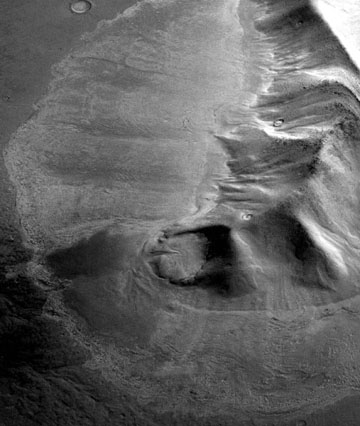 |
|
This handout image, released November 20, 2008, shows a perspective view of a mountain in the eastern Hellas region of Mars surrounded by a lobate deposit with flow textures on the surface. A radar instrument aboard a NASA spacecraft has detected large glaciers hidden under rocky debris that may be the vestiges of ice sheets that blanketed parts of Mars in a past ice age, scientists said on Thursday. [Agencies]
|
How old?
The sheer amount of ice present in the flows studied was surprising; extrapolating from the Hellas Basin feature to the many others present in both Martian hemispheres, there seems to be a lot of ice hiding under the Martian surface.
The researchers estimate that the amount of ice in these mid-latitude glaciers is about 1 percent of the ice that's in Mars' polar caps — roughly equivalent to the ratio of Earth's non-polar glaciers to its polar ice, Holt told SPACE.com. The glaciers could hold as much as 10 percent of the ice in the polar caps, similar to comparing Greenland's ice sheets to Antarctica, Holt added.
But just how the ice got there is still a mystery.
"You shouldn't have ice of this quantity at these latitudes," Holt said.
The theory is that the ice formed when Mars' orbital tilt was much different than it is now (the axis the planet spins on has considerable "wobble," meaning its angle changes over time) and the planet was much colder, allowing ice to form on the surface.
Ice on the surface of Mars today would immediately sublimate (or change directly into the gas phase). The rocky debris covering the ice is likely what keeps it in place today and has allowed it to survive below the surface for millions of years.
Scientists aren't exactly sure during which glacial ice in Antarctica preserves the record of traces of ancient organisms and past climate history."
Ancient ice layers in glaciers on Earth preserve the signature of the current atmosphere at the time that they formed. Head thinks the same could be true of the Martian glaciers. In particular, small bubbles that form as the ice layers are deposited could have "samples of the atmosphere at that time," he said.
A lander capable of drilling down several meters could be able to sample the ice in the glaciers.
"These are quite accessible to landers," Holt said.
They could also be a source of water for any future manned Mars expeditions. (When the researchers travel to Antarctica, for instance, they simply knock off chunks of ice and melt them instead of lugging water with them.)
"It's a lot of ice," Holt said. "You could support a base for a long time."

